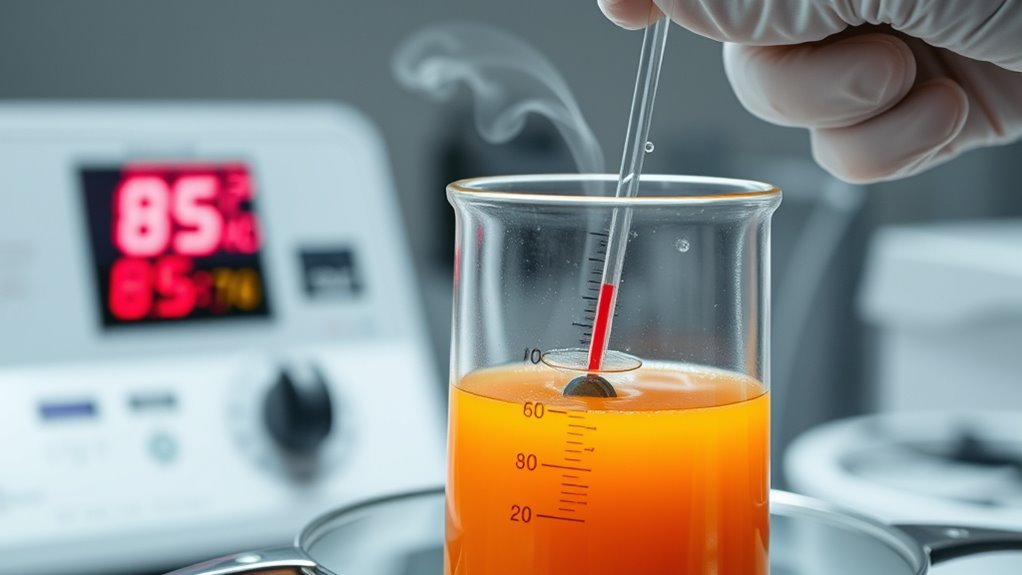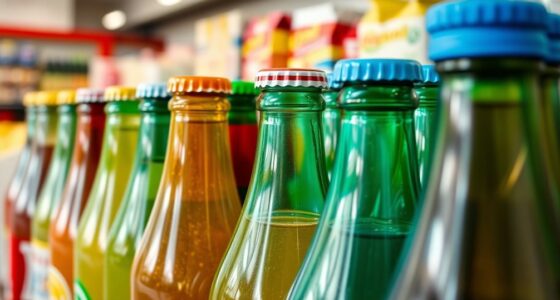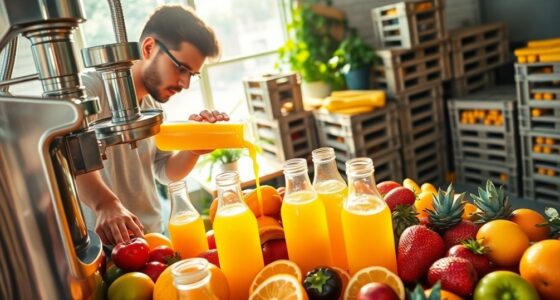To guarantee safety and preserve the flavor of stone-fruit juices, you should use pasteurization temperatures between 71°C (160°F) for 15 seconds (HTST) and 85°C (185°F) for longer periods. The exact temperature depends on fruit acidity, ripeness, and processing equipment. Proper adjustment reduces microbial risks while maintaining nutrients and flavor. If you want to discover detailed protocols and tips for optimizing quality, keep exploring further.
Key Takeaways
- Typical pasteurization temperatures for stone-fruit juices range from 71°C to 85°C (160°F to 185°F).
- Common protocols include HTST at 71.7°C (161°F) for 15 seconds or LTLT at 63°C (145°F) for 30 minutes.
- Adjust temperatures based on fruit pH, ripeness, and microbial load to balance safety and quality.
- Higher temperatures ensure microbial inactivation but may degrade flavor and nutrients; lower temps preserve quality.
- Proper calibration and validation of pasteurization processes are essential for safety and maintaining juice quality.
Understanding Microbial Safety in Stone-Fruit Juices

To guarantee the safety of stone-fruit juices, it’s essential to understand the microbial risks involved. Proper storage conditions are important to prevent microbial growth that can cause spoilage or illness. Keep juices refrigerated at the right temperature, typically below 4°C, to slow down bacteria and mold development. Packaging materials also play a key role; choose sturdy, food-grade containers that limit oxygen exposure and prevent contamination. Airtight packaging minimizes the risk of microbial intrusion during storage and transport. Always inspect packaging for integrity before sealing. By controlling storage conditions and selecting appropriate Packaging materials, you reduce the chances of microbial proliferation, ensuring your stone-fruit juices remain safe, fresh, and enjoyable for consumers. Maintaining proper temperature control is vital for inhibiting microbial activity and preserving juice quality. Additionally, implementing hygienic handling practices during processing further decreases contamination risks. Proper sanitation of equipment and workspaces is essential to uphold these safety standards. Understanding microbial safety principles helps in designing effective preservation strategies and ensures product integrity. Furthermore, staying informed about the latest machine learning tech can aid in predictive monitoring of microbial hazards, enhancing overall safety.
Factors Influencing Pasteurization Temperature Choices
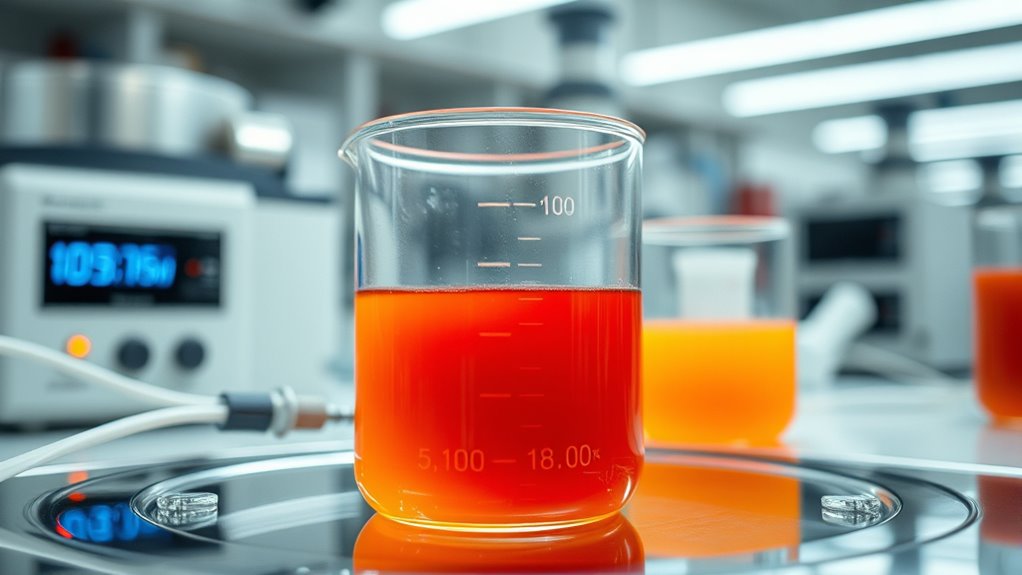
Several key factors influence the choice of pasteurization temperature for stone-fruit juices. One major consideration is pH variability; as the pH can fluctuate between fruit varieties and harvest times, it affects microbial stability and heat sensitivity. Juices with lower pH generally require less intense heat treatment, while those with higher pH might need higher temperatures for effective microbial inactivation. Seasonal fluctuations also play a role, since fruit ripeness and sugar content vary throughout the year, impacting juice composition and microbial load. You need to adjust pasteurization temperatures accordingly to guarantee safety without compromising quality. Understanding these factors helps you optimize pasteurization processes, balancing microbial safety with maintaining the fresh, natural qualities of your stone-fruit juices.
Common Pasteurization Protocols for Stone-Fruit Juices
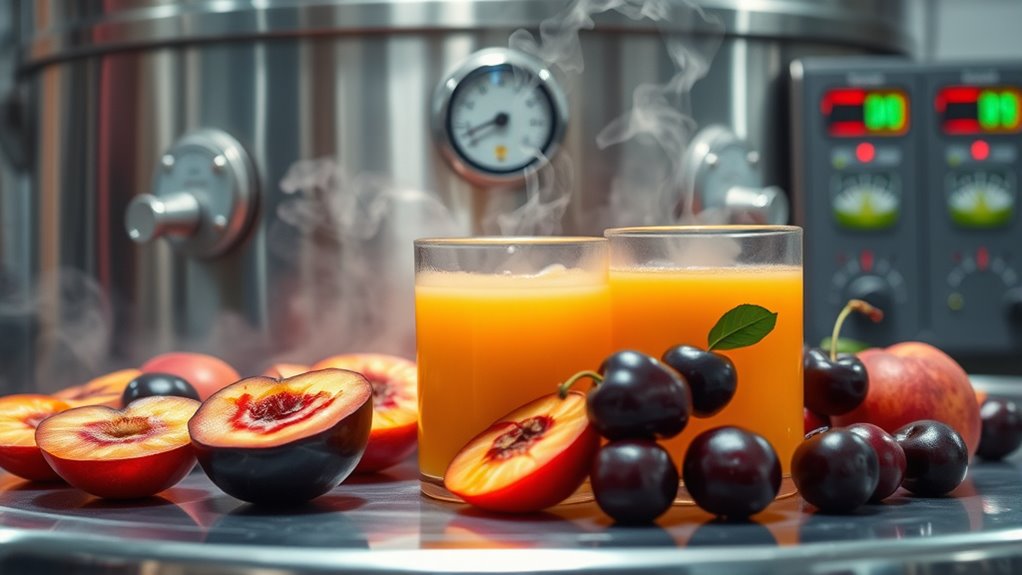
Choosing the right pasteurization protocol is essential for ensuring both the safety and quality of stone-fruit juices. Common protocols typically involve heating the juice to 71.7°C (161°F) for 15 seconds (high-temperature short-time, HTST) or maintaining 63°C (145°F) for 30 minutes (low-temperature long-time, LTLT). These processes effectively inactivate enzymes like pectin methylesterase, reducing cloud loss and maintaining clarity. When selecting a protocol, consider packaging considerations: heat-resistant containers can withstand higher temperatures, while delicate packaging may require gentler methods. Proper pasteurization also minimizes enzymatic activity that could lead to spoilage or quality degradation. Understanding temperature control is vital for optimizing pasteurization processes to preserve both safety and flavor. Additionally, precise temperature regulation is crucial to avoid overprocessing, which can negatively impact the juice’s flavor profile. Implementing consistent temperature monitoring during processing ensures uniform results and reduces the risk of under- or over-pasteurization. Overall, balancing temperature, time, and packaging ensures safety without compromising the juice’s flavor and texture.
Impact of Temperature on Juice Quality and Flavor
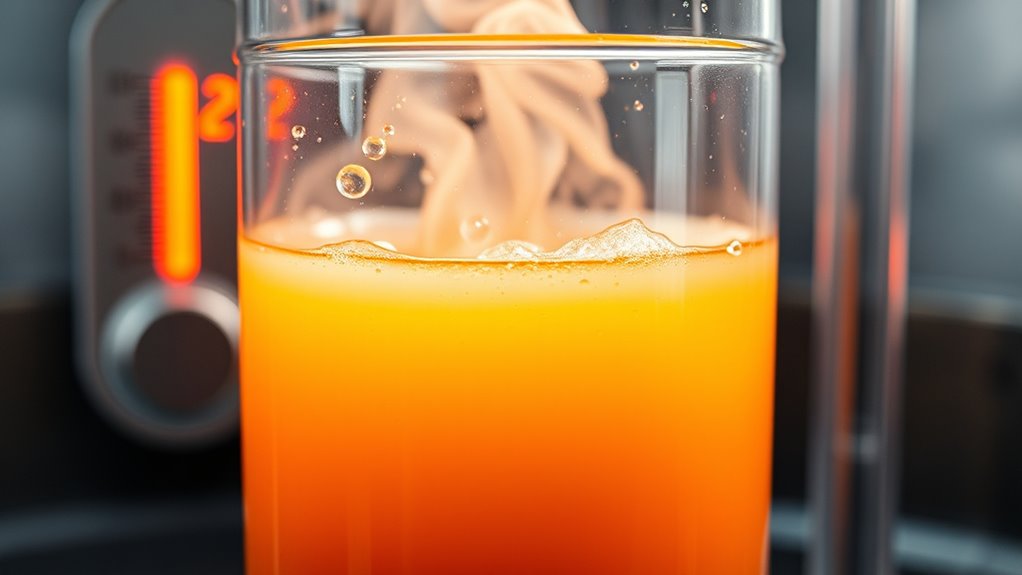
When you heat stone-fruit juices, it can affect their flavor and nutritional value. Using proper flavor preservation techniques helps maintain fresh taste, but higher temperatures may still cause some nutrient loss. Incorporating temperature control methods can further help retain the quality of the juice during processing. Additionally, understanding the thermal tolerance of the fruit’s nutrients can guide optimal temperature settings. Employing sound design techniques in processing equipment can optimize heat application and minimize damage to sensitive nutrients. Moreover, continuous monitoring of AI security measures during processing can prevent unauthorized access and ensure safety. Staying informed about industry trends can also help optimize the pasteurization process for better results.
Flavor Preservation Techniques
Temperature plays a crucial role in preserving the natural flavor of stone-fruit juices during pasteurization. To maximize flavor retention, you should carefully control the temperature to prevent overprocessing, which can diminish fresh taste. Lower pasteurization temperatures help preserve delicate aroma compounds, leading to aroma enhancement that makes your juice more appealing. Rapid heating and cooling techniques minimize flavor loss by reducing the exposure time to high temperatures. Using gentle pasteurization methods ensures that your juice retains its characteristic fruit notes without sacrificing safety. Monitoring and adjusting temperature precisely allows you to strike a balance between microbial safety and flavor quality. By focusing on ideal temperature control, you can deliver stone-fruit juices that boast vibrant flavor and enticing aroma, satisfying consumer expectations.
Nutritional Content Impact
The temperature used during pasteurization directly influences the preservation of nutrients in stone-fruit juices. Higher temperatures can lead to reduced vitamin stability, diminishing the juice’s nutritional value. To maintain maximum nutrient content, lower pasteurization temperatures help preserve essential vitamins like vitamin C and antioxidants. Additionally, fiber retention is affected by heat; excessive heat may break down structural components, reducing dietary fiber. By carefully selecting pasteurization temperatures, you can balance microbial safety with nutrient preservation, ensuring your juice retains its health benefits and natural flavor. Juice quality can be significantly impacted by heat levels, as higher temperatures may alter the natural composition and flavor profile. Keeping temperatures moderate minimizes nutrient loss while effectively eliminating pathogens. This approach allows you to offer stone-fruit juices that are both safe to consume and rich in nutrients, meeting consumer demands for nutrient preservation and healthfulness.
Adjusting Temperatures for Different Stone Fruits
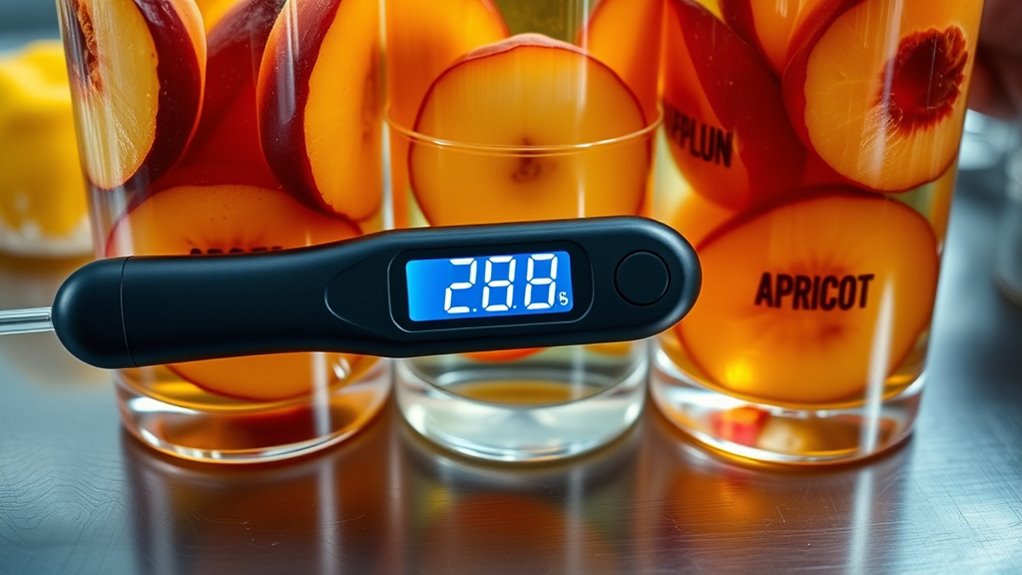
You need to adjust pasteurization temperatures based on the fruit’s acidity and ripeness to guarantee safety and quality. More acidic or riper fruits may require different heating times to preserve flavor and prevent spoilage. Carefully consider these factors to optimize your pasteurization process for each stone fruit type. Additionally, understanding the health benefits of juices can help in selecting the best fruit varieties to enhance nutritional value while ensuring safety. Incorporating proper storage methods is also essential to maintain juice quality after pasteurization and reduce the risk of contamination. Recognizing nutrient preservation techniques can further improve the overall health benefits of your fruit juices. Being aware of regional bank hours can also assist in planning any necessary banking transactions related to your juice business. Proper brewing techniques can be adapted to process and store the juices effectively, ensuring maximum freshness and safety.
Fruit Acidity Impact
Since fruit acidity varies among stone fruits, adjusting pasteurization temperatures becomes essential to guarantee safety without compromising quality. The fruit pH influences how heat affects juice, with more acidic fruits generally requiring lower temperatures to maintain acid stability. If the pH is lower, the juice tends to be more stable against microbial activity, allowing for slightly gentler pasteurization. Conversely, fruits with higher pH levels may need higher temperatures to ensure pathogen destruction, but excessive heat can degrade flavor and nutrients. Understanding the specific acid profile helps you determine ideal pasteurization conditions, balancing microbiological safety and juice quality. Proper adjustment based on fruit acidity ensures the juice remains safe, fresh, and true to its natural characteristics. Additionally, selecting a suitable dog name can reflect the personality of your fruit juice brand, creating a memorable identity for consumers. Recognizing product stability factors can further optimize processing parameters to extend shelf life and maintain quality over time. Incorporating knowledge of filtration technology can also aid in removing residual solids and improving clarity, enhancing overall juice quality. It is also important to consider the storage conditions of the juice post-pasteurization, as temperature and humidity can affect microbial growth and product longevity.
Variations in Ripeness
Ripeness levels considerably influence the ideal pasteurization temperature for stone-fruit juices. Ripeness variations affect fruit firmness, sugar content, and acidity, which in turn impact heat sensitivity. Fully ripe fruits often require slightly lower temperatures to prevent overprocessing, while underripe fruits may need higher temperatures for effective microbial inactivation. Harvest timing plays an essential role, as fruits harvested too early or too late can differ markedly in ripeness. Adjusting pasteurization temperatures based on ripeness ensures you preserve flavor, aroma, and nutritional quality without compromising safety. To determine the appropriate temperature, consider the fruit’s stage of ripeness at harvest and whether ripening occurred under ideal conditions. Properly calibrated temperatures accommodate ripeness variations, leading to consistent, high-quality juice production.
Optimal Heating Duration
Adjusting heating duration is essential because different stone fruits respond uniquely to pasteurization. Proper timing ensures effective enzymatic inactivation without compromising juice quality. You need to contemplate factors like thermal conduction efficiency, which varies with fruit texture and juice viscosity. Overheating can lead to nutrient loss, while underheating may leave enzymes active, risking spoilage. To optimize, monitor the following:
- Fruit firmness and ripeness
- Juice composition and viscosity
- Heat transfer rate during processing
- Target enzymatic inactivation levels
Balancing Safety and Freshness: Optimal Temperature Strategies
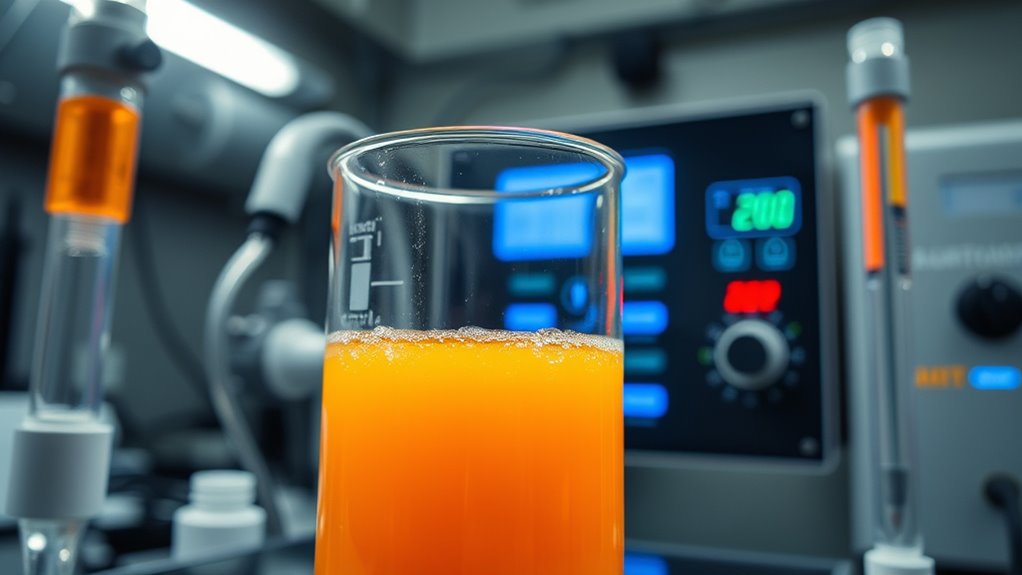
Balancing safety and freshness in stone-fruit juices requires carefully selecting pasteurization temperatures that effectively eliminate harmful microbes while preserving the juice’s natural flavors and nutrients. Your choice depends on packaging formats and storage conditions—bottles, cartons, or bottles with foil seals each respond differently to heat. Lower temperatures may better maintain fresh taste but could compromise safety if storage conditions aren’t ideal. Conversely, higher temperatures ensure microbial safety but risk flavor degradation. If you plan to store juices at room temperature, you’ll need slightly higher pasteurization temperatures, especially for less airtight packaging. Proper storage conditions, like refrigeration, allow for milder pasteurization, keeping the juice fresher longer. Balancing these factors helps you deliver safe, flavorful products that meet consumer expectations.
Monitoring and Validating Pasteurization Effectiveness
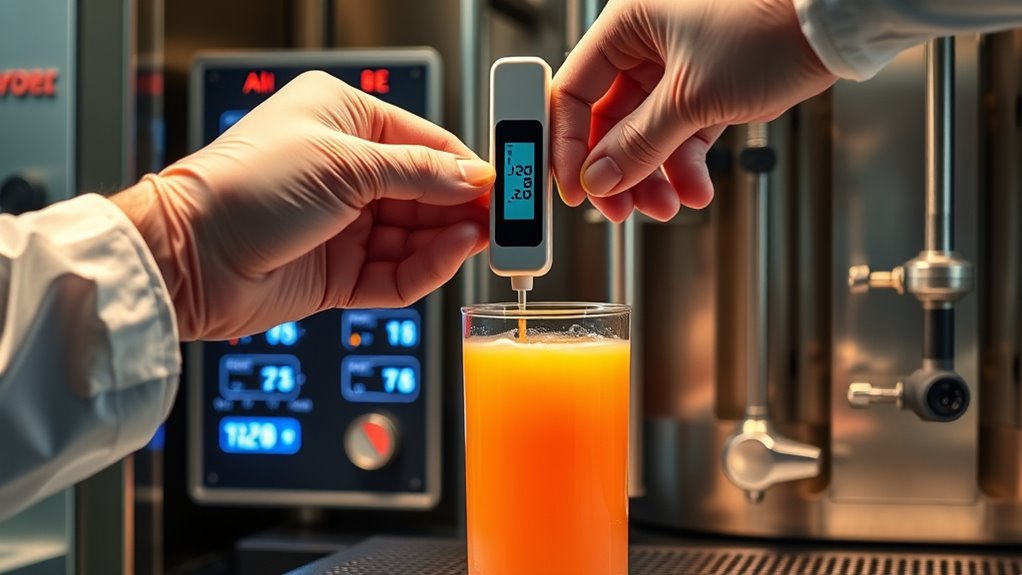
Effective monitoring and validation are essential to guarantee your pasteurization process consistently achieves microbial inactivation without compromising juice quality. Regularly verify that your process parameters meet established standards through precise temperature calibration, ensuring accurate readings. To confirm microbial safety, perform routine microbial testing on finished products and critical control points. Document all validation activities to demonstrate compliance and process consistency. Use trend analysis to identify deviations early, enabling prompt corrective actions. Additionally, validate your equipment’s performance periodically to maintain reliable temperature control. Incorporate the following practices for robust validation:
- Regular temperature calibration of pasteurization equipment
- Microbial testing of pasteurized juices
- Validation of process parameters against target temperatures
- Documentation of all monitoring results
Implementing these measures ensures your process effectively inactivates pathogens and maintains product safety.
Emerging Technologies in Juice Pasteurization
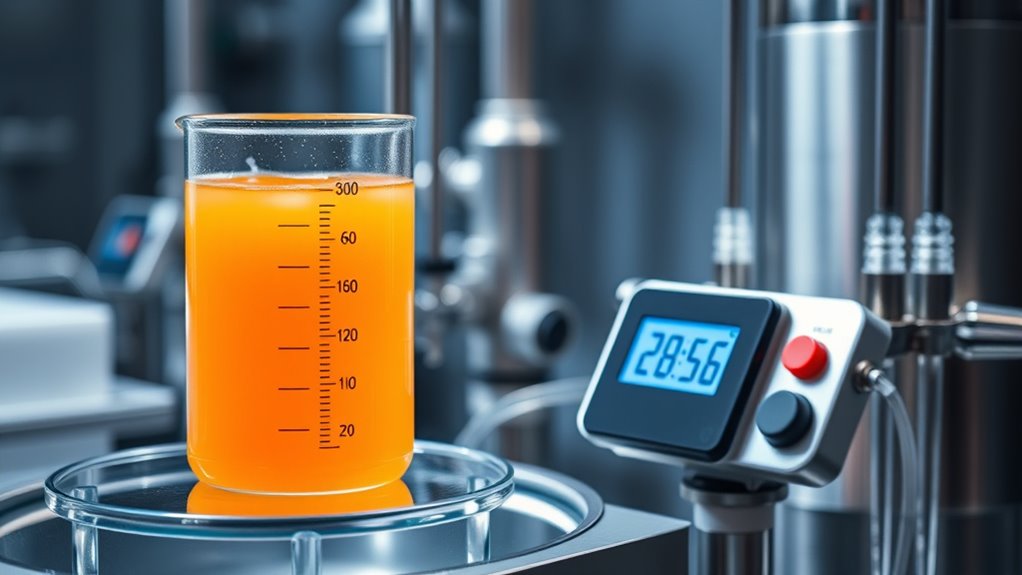
Emerging technologies are revolutionizing juice pasteurization by offering faster, more energy-efficient, and gentler methods to guarantee microbial safety. Cryogenic freezing quickly lowers juice temperatures, preserving flavor and nutrients while inactivating microbes without heat damage. This method reduces quality loss compared to traditional thermal pasteurization. Enzymatic inactivation also plays a crucial role, where specific enzymes are targeted and deactivated, preventing spoilage and enzymatic browning without heat exposure. These techniques allow you to process stone-fruit juices with minimal thermal impact, maintaining fresh taste and nutritional value. As these technologies advance, you’ll find they provide safer, more sustainable options for juice preservation, aligning with consumer demand for minimally processed, high-quality products. Embracing cryogenic freezing and enzymatic inactivation can set your products apart in a competitive market.
Frequently Asked Questions
How Does Pasteurization Temperature Affect Juice Shelf Life?
You might wonder how pasteurization temperature impacts juice shelf life. Higher temperatures effectively inactivate enzymes, preventing spoilage, and extend shelf life. However, excessive heat can reduce nutrient retention, diminishing vitamin content. Finding the right balance guarantees you maximize enzyme inactivation for longer storage while preserving as many nutrients as possible. So, optimizing pasteurization temperature helps you enjoy fresh-tasting, safe juice with a longer shelf life.
Are There Natural Preservatives That Influence Pasteurization Needs?
Imagine a garden where natural preservatives bloom, quietly protecting your juice. These substances, like lemon juice or honey, can sometimes reduce your need for high-temperature pasteurization. While they act as natural preservatives, they may serve as pasteurization alternatives, lowering the heat required. You can harness these options to extend shelf life naturally, reducing thermal stress on your juice and preserving more of its fresh flavor and nutrients.
What Are the Cost Implications of Different Pasteurization Temperatures?
When considering pasteurization temperatures, you should conduct a cost analysis to understand the financial impact. Higher temperatures often mean increased energy costs and potentially more sophisticated equipment investment, which can raise initial expenses. Conversely, lower temperatures might save on energy but could require longer processing times or additional safety measures. Balancing these factors helps you optimize costs while ensuring product safety and quality.
Can Pasteurization Temperatures Be Adjusted for Organic Stone-Fruit Juices?
Think of organic adjustments like tuning a fine instrument—you can optimize the temperature to preserve quality while ensuring safety. For organic stone-fruit juices, you can adjust pasteurization temperatures, but you need to balance microbial safety with minimal impact on flavor and nutrients. Temperature optimization allows you to tailor the process, possibly lowering temperatures slightly, yet still maintaining the organic integrity and ensuring the product remains safe and fresh for consumers.
How Do Consumer Preferences Impact Pasteurization Temperature Decisions?
You’re influenced by consumer preferences when deciding pasteurization temperatures, as they prioritize flavor preservation and minimal nutritional impact. If consumers favor fresh, vibrant flavors and nutrient retention, you might opt for lower temperatures. Conversely, if safety is paramount, higher temperatures could be necessary. Balancing these factors guarantees you meet consumer expectations while maintaining juice quality, ultimately shaping your pasteurization approach effectively.
Conclusion
By carefully selecting and fine-tuning pasteurization temperatures, you guarantee your stone-fruit juices stay delightfully safe and fresh. Embrace the gentle balance between microbial safety and vibrant flavor, allowing your products to shine while safeguarding your customers’ enjoyment. With thoughtful monitoring and emerging innovations, you can confidently craft juices that charm the senses and nurture trust. Ultimately, your attention to temperature nuances turns everyday juice into a truly memorable experience.
Susannah expertise lies in researching and compiling evidence-based content on juicing, nutrition, and overall health. She is committed to ensuring that The Juicery World offers accurate, up-to-date, and trustworthy information to empower readers to take control of their health. Susannah’s goal is to inspire individuals to embrace juicing as a way to nourish their bodies and live their best lives.

